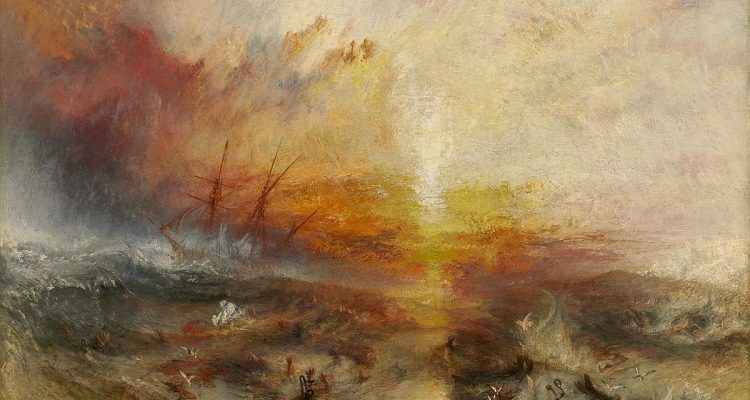I fully understand that a decent amount of art is hard to understand. It’s difficult to grasp why the all-black Marc Rothko paintings sell for tens of millions of dollars, or how an artist can become famous just for splashing paint across a canvas, like Jackson Pollock. They’re both parts of this Modern Art movement that has moved away from strictly hyper-realistic portraits to try and evoke more meaning and emotion within the viewer.
Which…if the feeling you get from these more abstract paintings is utter confusion, I totally get it! But, there are some pieces that stand out within this early Modern grouping of pure emotion-based/abstract paintings. “The Slave Ship,” originally titled, “Slavers Throwing Overboard the Dead and Dying—Typhoon Coming On” by J.M.W. Turner, is one of those paintings.
It pulses with this energy that a static, realistic painting wouldn’t have. The sky lights up with this orange glow, the splashing, pulsing waves crash across the horizon and just on the left-hand side, you can see the light brown outline of a ship in the distance. Then, as your eyes are dragging across the canvas, you see hands sticking out of the ocean.
They’re small, almost unnoticeable among the strong crashing of the waves. But, once you see them, and the thick chains wrapped around their wrists, you’ll notice the leg on the right side of the canvas. You’ll even start to ask yourself if the red color painted across the sea isn’t the reflection of the burning sun, but crimson-colored blood floating atop the water.
Turner painted “The Slave Ship” in 1840 after reading about the 1781 Zong Massacre, where 133 slaves were thrown overboard. They were worth more to the captain dead for the insurance payout than alive. Slavery was already abolished in England, where Turner lived, but he wished for that to spread to all nations.
Slavery existed in the United States for hundreds of years. Enslaved people were considered as nothing other than their economic worth to their owner. How much could they sell for? How much would their children sell for? It’s a horrific thought when you put it like that, but still, in the United States educational system, we have teachers asking their young students to give positives and negatives to the institution of slavery. As if there would ever be enough positives to make enslaving fellow human beings worth it.
The Black Lives Matter movement catapulted the nation into action through George Floyd’s death, another killing of a black man. Just one of the millions that have been killed at no fault of their own, but because we live in a country where institutional racism streams through the stripes of our flag. White Americans seem to only be spurred into action when confronted head-on with the violence black Americans have been living with their entire lives. It’s why Emmitt Till’s mother felt pushed to display her son’s mutilated body so publicly, a desperate cry to show what was happening, to try and spur change. To stop anything like that from happening again. To not have to suffer in silence.
This idea of quiet pain is what makes the fact that it took me so long to spot the hands in the water crucial.
I first saw the sun, then the ship and then finally my eyes were open to the hands in the water. But, once you see it, once you see their little wrists and the big sea creatures getting ready to consume them, you can’t ignore it.
Ignoring it, stepping away from the painting and choosing to see nothing other than the sunshine would be ignorance. You have to see the pain, the suffering, and then you have to act. Because those lives don’t just matter, they are so much more than that. The idea of what the people connected to those wrists could’ve been, what they could’ve accomplished if they weren’t stolen away and murdered, makes me sick.
That is the power of art.


Leave a Reply